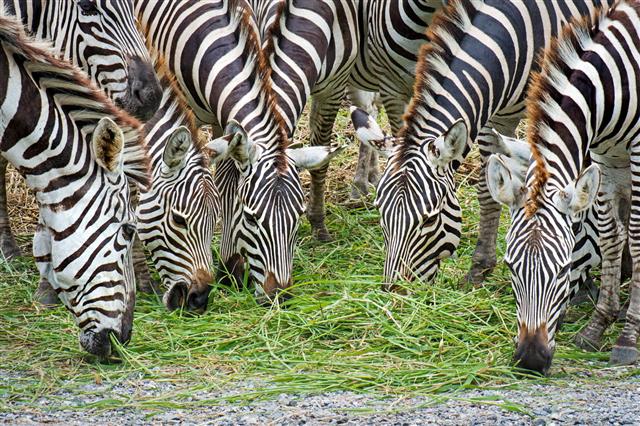
Zebras are grazers. They eat grass. For more on what zebras feed on, read on.
The word ‘zebra’ came from the Old Portuguese language word, zevra meaning wild ass. Zebras are species of equids (hoofed mammals with slender legs, a coat and a mane). It’s the group that horses and donkeys also belong to.
A Distinct Pattern of Black and White
What distinguishes zebras from other equids is the distinctive pattern of black and white stripes on their bodies. Each zebra has a unique pattern of white stripes on a black-colored coat.
Quick Read
- Their diet ranges from young shoots to full-grown grass.
- They are grazers living in herds.
- Zebras are herbivores.
- They are water-dependent and can adapt to a variety of grasses.
- Zebras aren’t ruminants.
Zebra Diet
The diet of zebras mainly consists of grass. Shrubs, twigs, bark and leaves are also a part of their diet. Their digestive system and metabolism are such that they can thrive on a low-nutrition diet. They can digest coarse grasses which other herbivores can’t. Thus zebras help other wild grazers by consuming coarse grass and leaving softer grass for them. They grip the grass with their lips and bite it off with their front teeth. They use their molars to grind the food.
Eating Habits
Zebras tend to remain in the proximity of water holes. Typically, they seek green pastures. During the dry months they thrive on dry grass. They inhabit grasslands, the savannas, as also the coastal, hilly or mountainous regions. Zebras have a large appetite. They spend almost 60% of the time of their day eating. They eat tall grasses growing in wet soils. When food is scarce, about 80% of their time is spent eating.
Wild Vs. Zoo
In the wild, zebras feed on even grass stems and sheath. In the zoos, they are fed hay, oats and alfalfa.
Diet of the Different Types of Zebras
Subspecies of Zebra
There are three species of zebras, namely, the Plains zebra, Grevy’s zebra and the Mountain zebra. The physical characteristics and habitats of these zebras vary and so does their diet. The Plains zebra and the Mountain zebra resemble a horse, while the Grevy’s zebra resembles an ass. Grevy’s and Mountain zebras are endangered.
Plains Zebras
They depend heavily on water. They migrate up to 700 miles in search of food and prefer migrating to locations where it rains. For food and water, these zebras depend on the rains. They prefer short grass for grazing, especially freshly grown, young grasses. They also eat leaves and shoots.
Grevy’s Zebras
Unlike Plains zebras, Grevy’s zebras are not dependent on water. They can survive without it for up to 5 days. These zebras eat grasses and legumes. Mares search for territories that offer good quality food and water resources. They may eat leaves and that makes for around 30% of their diet.
Mountain Zebras
They live in hot, dry, mountainous regions. They dig for ground water. They feed on tufted grass, leaves, bark, buds and fruit. Mountain zebras are classified into two sub-species, namely Cape mountain zebras and Hartmann’s mountain zebras. Cape mountain zebras feed on grass. If left with little choice, they eat bushes. Hartmann’s zebras feed on stems, roots and leaves apart from grass. These zebras drink water any time of the day, but with the fear of being hunted, they prefer the nighttime.
Zebras are Not Ruminants
Unlike other grazing animals, zebras do not ruminate. This is why they extract less nutrition from the food they eat. From this arises their need to graze all day. Search for food is the prime reason for their migration. Generally, wildebeests and zebras migrate together. They are often seen grazing together. An interesting thing about the way zebras graze is that some bend down to eat while others look around to guard against predators.
Due to overgrazing and preference to livestock, zebras are losing their habitat. Their food sources are diminishing. They are under the threat of extinction. Let’s do our bit towards saving them.













